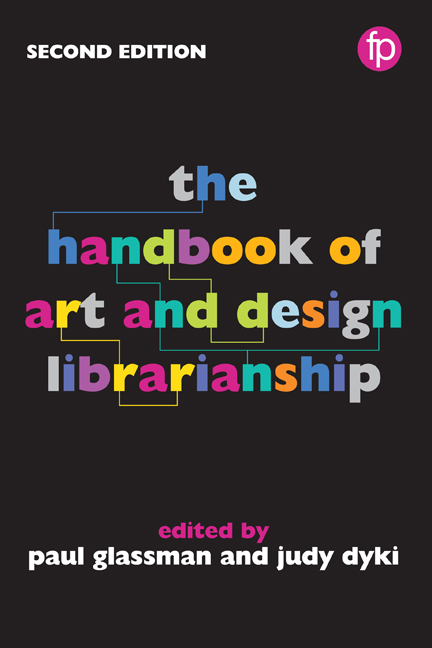Book contents
- Frontmatter
- Contents
- List of figures and tables
- Notes on contributors
- Foreword
- Preface
- Part I Roles and responsibilities
- Part II Materials and collection management
- 6 Visual resources: from analogue to digital and beyond
- 7 Developing digital collections
- 8 Inspirational encounters: the management and use of archives and special collections in the art and design library
- 9 What is special about special collections?
- 10 Artists’ books in the art and design library
- 11 Art documentation: exhibition catalogues and beyond
- 12 Tactile libraries: material collections in art, architecture and design
- 13 Seeing the bigger picture: archival description of visual information
- Part III Teaching and learning
- Part IV Knowledge creation
- Part V The physical environment
- Part VI Promotion and sustainability
- Appendix Library profiles
- Index
12 - Tactile libraries: material collections in art, architecture and design
from Part II - Materials and collection management
Published online by Cambridge University Press: 08 June 2018
- Frontmatter
- Contents
- List of figures and tables
- Notes on contributors
- Foreword
- Preface
- Part I Roles and responsibilities
- Part II Materials and collection management
- 6 Visual resources: from analogue to digital and beyond
- 7 Developing digital collections
- 8 Inspirational encounters: the management and use of archives and special collections in the art and design library
- 9 What is special about special collections?
- 10 Artists’ books in the art and design library
- 11 Art documentation: exhibition catalogues and beyond
- 12 Tactile libraries: material collections in art, architecture and design
- 13 Seeing the bigger picture: archival description of visual information
- Part III Teaching and learning
- Part IV Knowledge creation
- Part V The physical environment
- Part VI Promotion and sustainability
- Appendix Library profiles
- Index
Summary
Phenomena exist in the material world.
Material makes thoughts tangible.
Materials manifest the world.
(Viray, 2011, 8)What is a materials collection?
A materials collection is ‘a body of physical items and samples acquired across various industries to be utilised as objects for inspiration and in project specification by architects, designers, artists, and researchers in the practice of those and allied fields’ (Pompelia, 2013, 1). Like all library collections, materials collections are as varied and unique as the institutions they serve. While these collections have long been found in design firms, in recent decades their presence in academic settings has increased (Jost, 2011). By offering materials samples for exploration by students, faculty, designers, artists and practitioners, materials collections provide an intimate and tactile means of exploring the physical vocabulary of the built environment.
For patrons, materials collections offer opportunities to engage physically with samples. Tactile interactions can promote creativity and innovation in ways that viewing materials online or in texts cannot. For artists and designers, the experience of an object or space is of paramount importance and is deeply affected by the selection of materials. Through direct physical contact, one can come to better understand a material and be inspired by its possibilities. The browsability of these collections frees visitors from exploring via search boxes and facets and allows for serendipity. Researchers in a materials collection frequently pick up a material because it looks interesting, shiny, bright or translucent. They dismiss labels that indicate that a sample is marketed as flooring, insulation or for erosion control. As they hold, bend or peer through a material, it transforms and inspires – physical contact catalyzes the design process.
The role of materials in design has been well documented in scholarship and theory (Beylerian and Dent, 2007; Kolarevic and Klinger, 2013; Schröpfer, 2011). Scientific advances have led to a proliferation of new materials that are available for provocation, use and ‘misuse’ by designers. As Manuel Kretzer notes in his discussion of the changing nature of materiality, ‘applying the right materials … represents a truly demanding task and requires not only knowledge and experience on the various material properties, but also sensitivity and intuition in anticipating their meaning and value over time’ (2016, 26). Physical interaction with materials is essential to this process.
- Type
- Chapter
- Information
- The Handbook of Art and Design Librarianship , pp. 119 - 128Publisher: FacetPrint publication year: 2017

